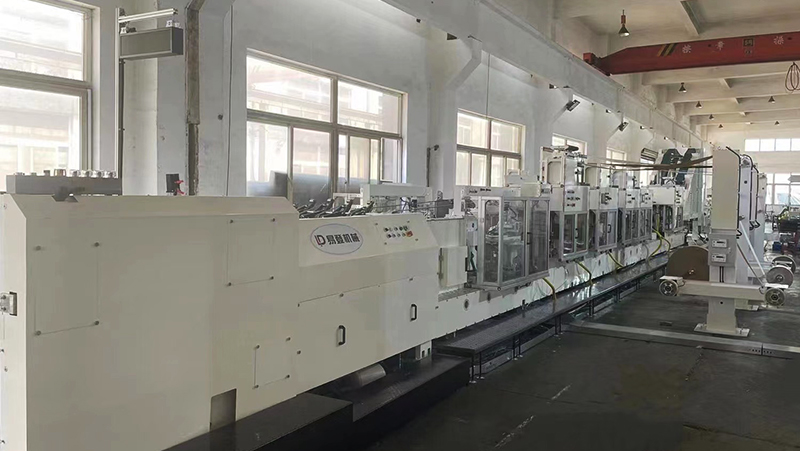Revolutionizing Packaging Efficiency: The Advanced Design and Applications of Self-Opening Paper Sack Machines
Release time:2025-05-26 Classification:Knowledge
In modern industrial packaging, speed, precision, and sustainability are non-negotiable demands. Among the innovations addressing these needs, the self-opening paper sack machine stands out as a transformative solution for high-volume production environments. This equipment streamlines the creation of paper sacks with minimal manual intervention, offering a blend of automation and adaptability that redefines packaging workflows. Below, we explore its operational principles, technical advantages, and diverse industrial applications.

Core Operational Principles
A self-opening paper sack machine automates the formation of pre-glued paper sacks, enabling rapid transition from flat sheets to ready-to-fill containers. The process begins with feeding layered paper rolls into the machine, where precision-cut blanks are folded and sealed. The defining feature lies in its ability to generate a "self-opening" mechanism: integrated creasing and folding systems create a natural opening tendency, allowing sacks to spring open seamlessly during filling. Advanced models incorporate optical sensors to detect glue patterns and adjust folding parameters in real time, ensuring consistent sack geometry.
Key Technical Components
- Automatic Sheet Feeder: Ensures continuous material supply, reducing downtime between production cycles.
- Precision Rotary Cutters: Laser-calibrated blades deliver clean, dimensionally accurate cuts.
- Multi-Stage Folding Units: Sequential rollers and pneumatic arms form the sack’s gussets and bottom seals.
- Integrated Quality Control: Vision systems inspect glue application and structural integrity, rejecting defective units.
- Programmable Logic Controllers (PLCs): Customizable settings for sack dimensions, throughput rates, and material compatibility.
Advantages Over Conventional Systems
- Enhanced Productivity: Capable of producing 80–120 sacks per minute, these machines outperform manual or semi-automatic alternatives by 300–400%.
- Material Optimization: Adaptive algorithms minimize paper waste during cutting, achieving up to 98% material utilization.
- Labor Reduction: Fully automated operation slashes staffing needs for sack preparation, redirecting human resources to value-added tasks.
- Versatility: Compatible with recycled, kraft, or laminated papers, supporting diverse weight capacities (5–50 kg).
- Sustainability: Reduced energy consumption (15–25% lower than traditional systems) aligns with eco-friendly manufacturing goals.
Industrial Applications
Self-opening paper sack machines cater to sectors requiring bulk packaging with rapid turnaround:
- Food Industry: Flour, sugar, and grain packaging with FDA-compliant material options.
- Construction: Cement, mortar additives, and insulation materials in moisture-resistant sacks.
- Agriculture: Fertilizers, animal feed, and seed storage solutions.
- Chemicals: Customizable liners for non-reactive powder or granular substances.
The machines’ ability to handle reinforced seams and multi-ply designs makes them ideal for heavy-duty applications, while optional UV-resistant coatings extend shelf life for outdoor storage.
Maintenance and Durability Considerations
Constructed with hardened steel components and corrosion-resistant alloys, these machines withstand 24/7 operation in humid or dusty environments. Routine maintenance focuses on:
- Lubrication of chain drives and bearings.
- Calibration of tension controls for paper feed systems.
- Software updates for PLCs to maintain synchronization.
Many systems feature self-diagnostic modules that alert operators to wear-prone parts, preempting unplanned downtime.
Future Developments
Emerging trends include AI-driven predictive maintenance, which analyzes vibration and temperature data to forecast component failures. Additionally, integration with IoT platforms enables remote monitoring of production metrics. Innovations in adhesive technologies—such as bio-based glues—further enhance the eco-profile of self-opening sacks without compromising seal strength.
The self-opening paper sack machine represents a convergence of engineering precision and operational intelligence. By eliminating bottlenecks in sack preparation, it empowers manufacturers to meet escalating demands for speed and sustainability. As industries increasingly prioritize automated, waste-conscious processes, this technology solidifies its role as a cornerstone of modern packaging infrastructure. Investing in such systems not only boosts output but also future-proofs operations against evolving regulatory and market pressures.






